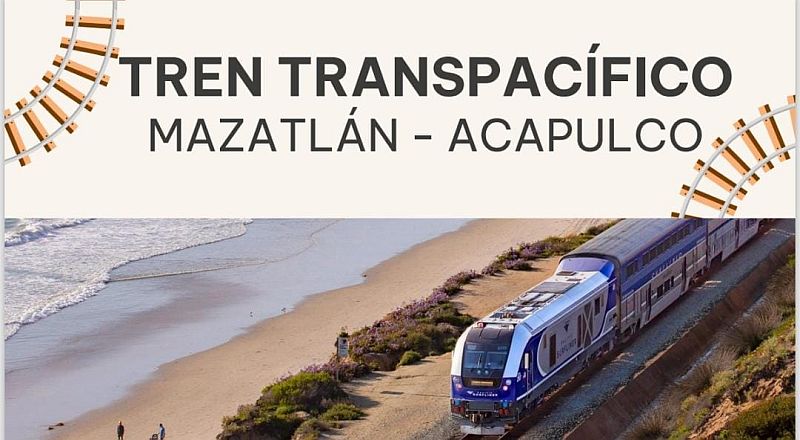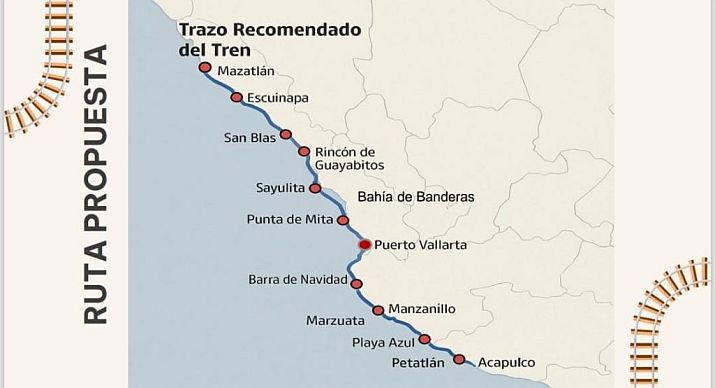
Puerto Vallarta, Jalisco, Mexico – A bold new proposal could reshape tourism along Mexico’s Pacific coast. The National Chambers of Commerce and Tourism in Puerto Vallarta (CANACOPE) and Bahía de Banderas-Compostela (CANACO Servytur) are championing the creation of a Transpacific Tourist Train, which would link Mazatlán, Sinaloa, to Acapulco, Guerrero, traveling over 1,200 kilometers and connecting 45 coastal destinations.
Originally introduced to the Senate in 1994, the project seeks to revive and modernize the idea as a scenic, multi-day train journey showcasing the natural beauty and cultural richness of Mexico’s Pacific region. Modeled after a cruise-style experience, travelers would enjoy scenic routes, onboard entertainment, and the chance to explore various coastal towns and cities, from established hubs like Puerto Vallarta, Bahía de Banderas, and Acapulco to emerging destinations in Michoacán, Colima, and Jalisco.
“There are 45 destinations along this route, and 35% of national hotel occupancy is concentrated here. It’s a corridor with enormous tourism potential,” said Carlo Gómez, President of CANACOPE Puerto Vallarta. According to Gómez, the project has already drawn interest from influential stakeholders including tourism developers, private investors, and Ferromex, which has high-end train cars available.
While the project is still in its initial stages, with a finalized route and executive plan yet to be developed, early discussions suggest an investment exceeding US$100 million. Discussions with private investors and international partners, including the Chinese government, are underway to secure funding and technical support, especially for infrastructure and manufacturing.

Supporters emphasize that the train is more than a tourist attraction – it’s a regional development strategy. “It will reduce transportation costs, promote local commerce, and allow lesser-known towns to grow alongside established destinations,” said Juan Carlos Fortanel González, strategy advisor for the chambers. He noted the potential for up to 20% growth in sales of food, crafts and community services, especially in hard-to-reach places like San Blas, Maruata and Petatlán.
With 87% of Mexican businesses classified as small and medium enterprises (SMEs), many of which operate near the proposed stops, the train could open new markets and offer consistent visitor traffic to communities that currently rely on seasonal tourism.
Optimism surrounds the project as meetings with government officials and private sector partners continue. A familiarization trip to China is being organized to present the project and potentially secure investment or technological collaboration.
Proponents of the Transpacific Tourist Train hope the government will embrace the initiative with strong private sector support. They draw parallels to the success of the Mayan Train project, arguing that if a similar endeavor could thrive in a region with fewer established tourism hotspots, a Pacific train in an already flourishing tourism corridor holds even greater promise.
Fortanel González expressed his long-term vision: “If it’s achieved, which I hope it is… maybe we won’t see it, but our children will… it will be the train of Mexico, because it will connect the most beautiful cities of the Mexican Pacific, which represents 33% of tourism in our country.”
As Gómez put it, “If we managed to build the Mayan Train in a region with fewer tourism hotspots, why not develop this train along the Pacific, where tourism is already thriving?”

We need your support to keep Banderas News thriving. As more and more news outlets resort to paywalls, we remain steadfast in our mission to provide free, quality journalism to Puerto Vallarta residents and visitors. Your contribution helps us maintain this commitment and continue serving our community.





